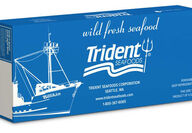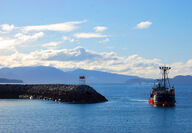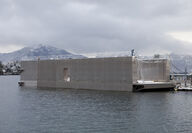Sorted by date Results 560 - 584 of 588
Thanks to a nearly $3 million show of support from the state, high tech buoys will soon be measuring ocean acidity levels year ‘round, and Alaska fishermen will play an important role in the research. Basic chemistry proves that ocean waters are becoming more corrosive and it is happening faster in colder waters. The acidity, caused by increasing carbon dioxide emissions, can prevent shells from forming on crabs or oysters and tiny shrimplike organisms essential to fish diets. Alaska’s monitoring project will allow scientists to develop a “se...
Sea otters are expanding throughout Southeast Alaska and dining on crab, sea cucumbers, geoduck clams and more as they go. An ongoing study aims to track the otters, what they’re eating and where they are going – and researchers hope to get ‘grounds truth’ from Southeast residents. For the past two years, Sea Grant marine advisory agents have spearheaded a project to learn more about the region’s sea otter diets and behaviors. The US Fish & Wildlife Service has provided aerial surveys and otter tagging to track their movements around Kupreono...
The Alaska Department of Fish and Game has rescinded a previous order that liberalized sport fishing for king salmon in waters surrounding Wrangell and Petersburg. Effective June 4, the resident bag and possession limit is three king salmon 28 inches or greater in length, while the nonresident bag and possession limit is one king salmon 28 inches or greater in length. A nonresident annual limit of four king salmon 28 inches or greater in length is also in effect. Between Oct. 1, 2012-March 31, 2013 all sport anglers may use two rods while...
The Alaska Department of Fish and Game announced last week that District 8 gillnet fisheries would remain closed until run sizes increase. The first in-season forecast is projecting a terminal run size of 29,300 Stikine River Chinook salmon. That forecast is well below the preseason levels for commercial fishing. The District 8 gillnet fishery will remain closed until the sockeye salmon season – unless in-season projections of Stikine River Chinook salmon increase. The in-season terminal run size estimate for Taku River Chinook salmon r...

Nobody wants to waste fish – least of all those who make their living from the sea. Fish harvesters want and need to be able to catch as much as they can to sustain their families and livelihoods. And as upstanding citizens, they obey the law when they discard “prohibited species” taken while they’re fishing for their “target catch.” When fishing seasons open, it’s impossible to not catch a mix of fish when they blanket the sea bottom, and fish of all kinds and sizes will go after a baited hook...
The value of Alaska fishing permits has see-sawed over the past year with Cook Inlet prices heading upwards and Bristol Bay on the down side. “Cook Inlet had a really good year last year, and they’re expecting another strong fishery this summer. Salmon drift permits have taken off with sales made at $80,000 compared to around $50,000 last year,” said Doug Bowen of Alaska Boats and Permits in Homer Prices have headed the other way in Bristol Bay. The Bay permits, are not so hot. They ran way up last year on expectations of good fish numbers...
Several Alaska towns are vying for the title of ‘Ultimate Fishing Town’ which comes with a $25,000 check for local fishing projects. The annual competition is sponsored by the World Fishing Network, “a 24/7 television network dedicated to all segments of fishing,” according to its website. WFN, which focuses on sport fishing, originally launched in 2005 and is now seen in more than 20 million North American households via cable, satellite and the Internet. As of Friday, nine Alaska towns were among the hundreds of hopefuls on the leaderb...
The Alaska Department of Fish and Game recently announced that the lingcod sport fishing seasons, bag and possession limits, annual limits, and size limits have been established for the Northern Southeast Area. In this area the following regulations apply: Northern Southeast Area - Season: May 16 – November 30. Limits: Residents – 1 daily 2 in possession, no size limit. Nonresidents – 1 daily, 1 in possession, size limit: 30 inches or greater in length and less than 35 inches in length, or 55 inches or greater in length. An annual limit of 2...
The Alaska Department of Fish and Game recently announced that the lingcod sport fishing seasons, bag and possession limits, annual limits, and size limits have been established for the Southern Southeast Area. In this area the following regulations apply: Southern Southeast Area - Season: May 16 – November 30. Limits: Residents – 1 daily 2 in possession, no size limit. Nonresidents – 1 daily, 1 in possession, size limit: 30 inches or greater in length and less than 45 inches in length, or 55 inches or greater in length. An annual limit of 2...
Soccer balls …motorcycles…reminders of the massive tsunami in Japan a year ago are now appearing along Alaska’s coastlines. “It’s safe to say that tsunami debris is here,” said Merrick Burden, director of the Juneau-based Marine Conservation Alliance Foundation. Since January the MCA has been tracking where and the kinds of debris that is coming ashore, and whether it is radioactive (none so far), at Kodiak, Yakutat, Sitka and Craig where the wreckage was first likely to hit. “What we’re finding are wind driven objects like buoys, Styrofo...
It has taken a quarter of a century, but fishery managers are finally poised to take action to reduce the five million pounds of halibut allowed to be taken as bycatch in Gulf of Alaska (GOA) fisheries. Industry watchers are hoping that public comments will sway them to make the largest cuts under consideration. Currently, 2,300 metric tons of halibut bycatch is allowed in the GOA groundfish fisheries. That is further broken down to 2,000mt for the trawl sector and 300mt for hook and line fisheries, primarily the cod fleet. Those are the two f...
SEATTLE (AP) — Fire destroyed an adventure tour boat being prepared for the Alaska cruise season Friday at Fishermen's Terminal, and the operator says the loss likely will total millions of dollars. Two people escaped from the Safari Spirit by climbing down a mooring line to the dock, said Tim Jacox, vice president of InnerSea Discoveries. Company owner Dan Blanchard was sleeping on board and was awakened at about 1 a.m. by popping noises. He called the fire department and got off the boat along with the engineer, Jacox said. The 105-foot yacht...
Brainstorming over halibut bycatch is the theme of a two day workshop this week in Seattle. Topping the discussions: the methods used to collect bycatch numbers and the accuracy of the data. Setting a precedent: the IPHC and NPFMC working together to reduce the estimated 10 million pounds of halibut taken as bycatch and discarded in Alaska’s fisheries. “As far as I know, this meeting represents a first ever joint effort by the two bodies to meet together to discuss current “science” and/or research,” said Duncan Fields of Kodiak, a membe...
A resurgence of farmed fish and shifting world currencies could shake up salmon markets this year. “There are two trends going into the current salmon season that we haven’t seen for several years,” said Gunnar Knapp, a fisheries economist at the University of Alaska at Anchorage. “Exchange rates look to be weaker, not stronger, and perhaps more importantly, farmed salmon prices, rather than rising or holding steady, have fallen significantly. So we will be selling into a market where there is a lot more competing product available at a lot...
For the first time ever, seafood industry reps were invited to brief policy makers in Congress on jobs and economic opportunities. Last Thursday the group presented a panel discussion called ‘Seafood Jobs in America’ to the Senate Oceans Caucus and an audience of 80 people. According to Seafood.com, it included representatives of twelve senators and even one from the White House, plus a large contingent from the environmental NGO community. Alaska Senators Lisa Murkowski and Mark Begich both made opening remarks at the event. “Nobody else...
ANCHORAGE, Alaska (AP) – A derelict Japanese ship dislodged by last year’s massive tsunami was drifting toward Alaska Monday, the U.S. Coast Guard said. The shrimping vessel was floating slowly northwest in the Gulf of Alaska about 125 miles west of the nearest point of land, Forrester Island outside the Dixon Entrance, a maritime transportation corridor separating U.S. and Canada jurisdictions. The ship is heading in the direction of the southeast Alaska town of Sitka 170 miles to the north, traveling at about one mile per hour, Coast Gua...
Fishermen in the world’s largest salmon fishery at Bristol Bay are getting good grades for improving the quality of their salmon, and it’s boosting their bottom line. Starting in 2008, two projects have tracked fish quality based on specific handling practices, and given individual fishermen scores on their improvements (or not). “The two studies go hand in glove. First you get a score and understand where you are, and secondly, if you wish to improve, then you can start changing the way you handle your fish out on the water to bring your score...
The Pacific halibut fishery gets underway on March 17 and if the dynamic of supply and demand holds true, there will be an upward push on prices. The coast wide halibut catch was reduced by more than 18% this year to 33.5 million pounds, following a 19% cut to the catch last year. Alaska’s share of the harvest is 25.5 million pounds. That will be shared by roughly 2,200 Alaska longliners who hold quota shares of the halibut catch. Fresh halibut of the season will undoubtedly fetch over $6/lb at major ports. The average price for halibut d...

A fishing boat heads into Heritage Harbor in Wrangell Monday afternoon. Alaska’s commercial halibut fishing season opened Saturday, March 17. Southeast Alaska is the only area in the state that had its catch limit increase this year by the International Pacific Halibut Commission. The increased catch limit of 2,624,000 pounds of halibut — up approximately 300,000 pounds from the 2011 season — was approved by the Commission in January....
Home grown salmon are Alaska’s largest crop – but don’t ever refer to it as farming. Whereas farmed fish are crammed into closed pens or cages until they’re ready for market, Alaska salmon begin their lives in one of 35 hatcheries and are released as fingerlings to the sea. When the fish return home, they make up a huge part of Alaska’s total salmon catch. The state’s annual report on its fisheries enhancement programs show that last year, hatchery returns and harvests were down by more than half from 2010, when a record 77 million hatchery sa...
SITKA, Alaska (AP) — The Department of Fish and Game says aerial surveys will begin Tuesday in preparation for the first opening of the Sitka Sound sac roe herring fishery. Area management biologist Dave Gordon tells the Daily Sitka Sentinel that the guideline harvest level of 28,829 tons is based on a forecast biomass of 144,143 tons. The guideline harvest is down slightly from the preliminary figure of 29,008 tons announced in December. The guideline harvest last year was 19,490 tons and commercial fishermen hauled in 19,429 tons in five o...
Trident Seafoods in Wrangell plans to begin processing fish oil this year, which will be used to create fish oil capsules for human consumption. The oil extraction operation will generate just over $7,000 for the city annually and is expected to create several new jobs in the community. The oil extraction equipment will be installed this spring at Trident’s belt freezer facility in Wrangell, and oil extraction from salmon heads will begin in time for the summer’s salmon fishing season, said Paul Padgett, who is in charge of Trident’s Alask...
State fishery managers project a lower Alaska salmon harvest this year, due to an expected decrease in those hard to predict pinks. The total catch forecast by the Alaska Dept. of Fish and Game is 132 million salmon, down 25% from the 177 million fish taken in 2011. The statewide breakdown is 120,000 Chinook salmon (in areas outside Southeast, where catches are dictated by treaty with Canada); 38.4 million sockeye salmon, a decline of 4%; 4.3 million coho (similar to last year); 19 million chums, 12% higher; and 70.2 million pinks,...
It’s a mixed bag in America in terms of bankrolling ‘the best available science’ for our nation’s fisheries. Based on the preliminary federal budget released last week, funds for the National Oceanic and Atmospheric Administration went from $4.7 billion to $5.5 billion, an increase of about $750 million. Within the NOAA budget, funding for the National Marine Fisheries Service comes in at $1 billion - a drop of $15 million from its actual budget for the last fiscal year. Out of NMFS’ FY13 budget, $174 million will fund science and man...

Over half of all fishing fatalities are due to vessels going down, and most of the boats sink because of flooding. The sinkings of the Alaska Ranger and Katmai in 2008, for example, in which12 men died, both stemmed from flooding through open hatches. Those and other sinkings highlighted the need for an alert that provides immediate status of all openings aboard fishing boats. To the rescue: a simple electronic monitoring system on doors and hatches that sends signals to the...